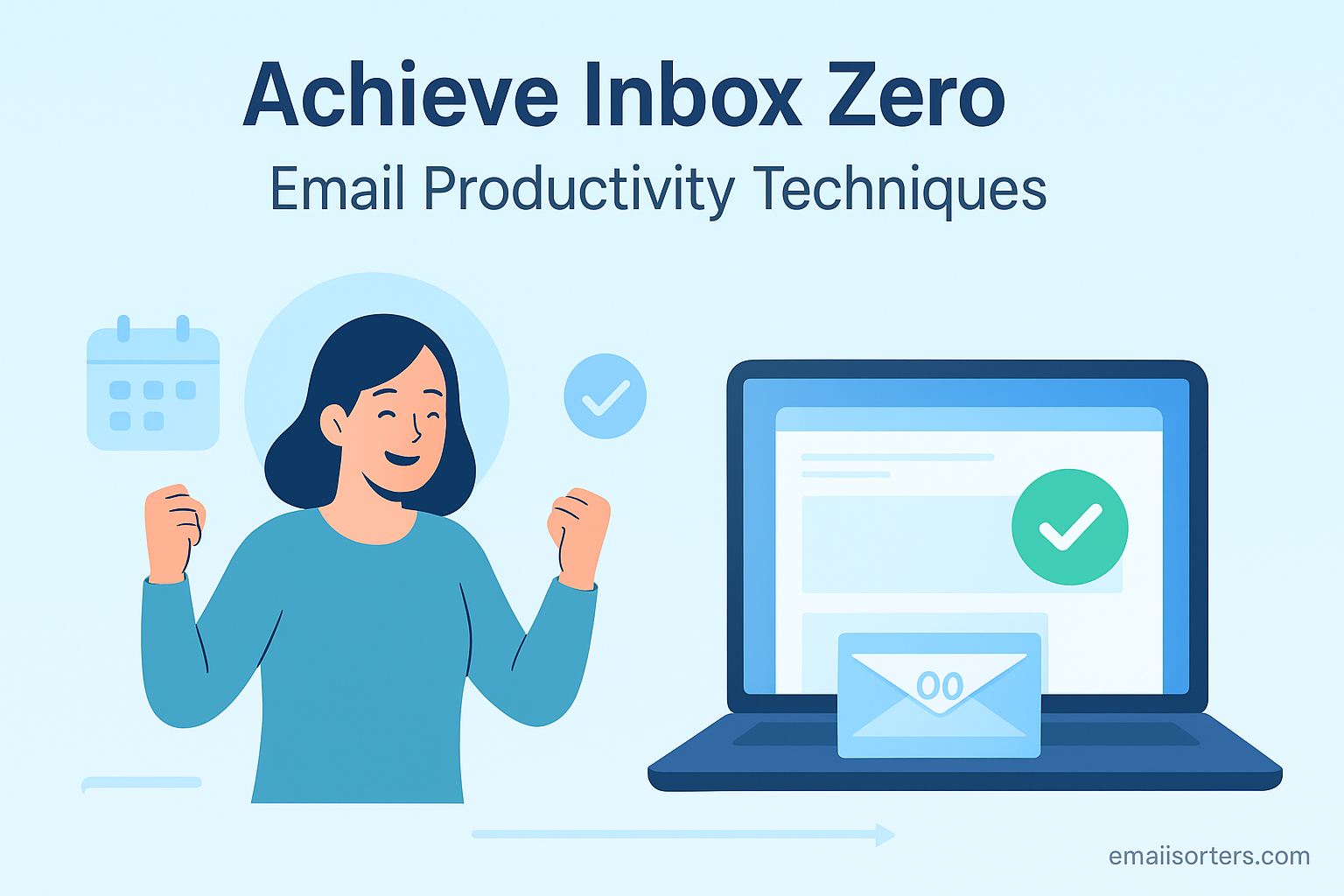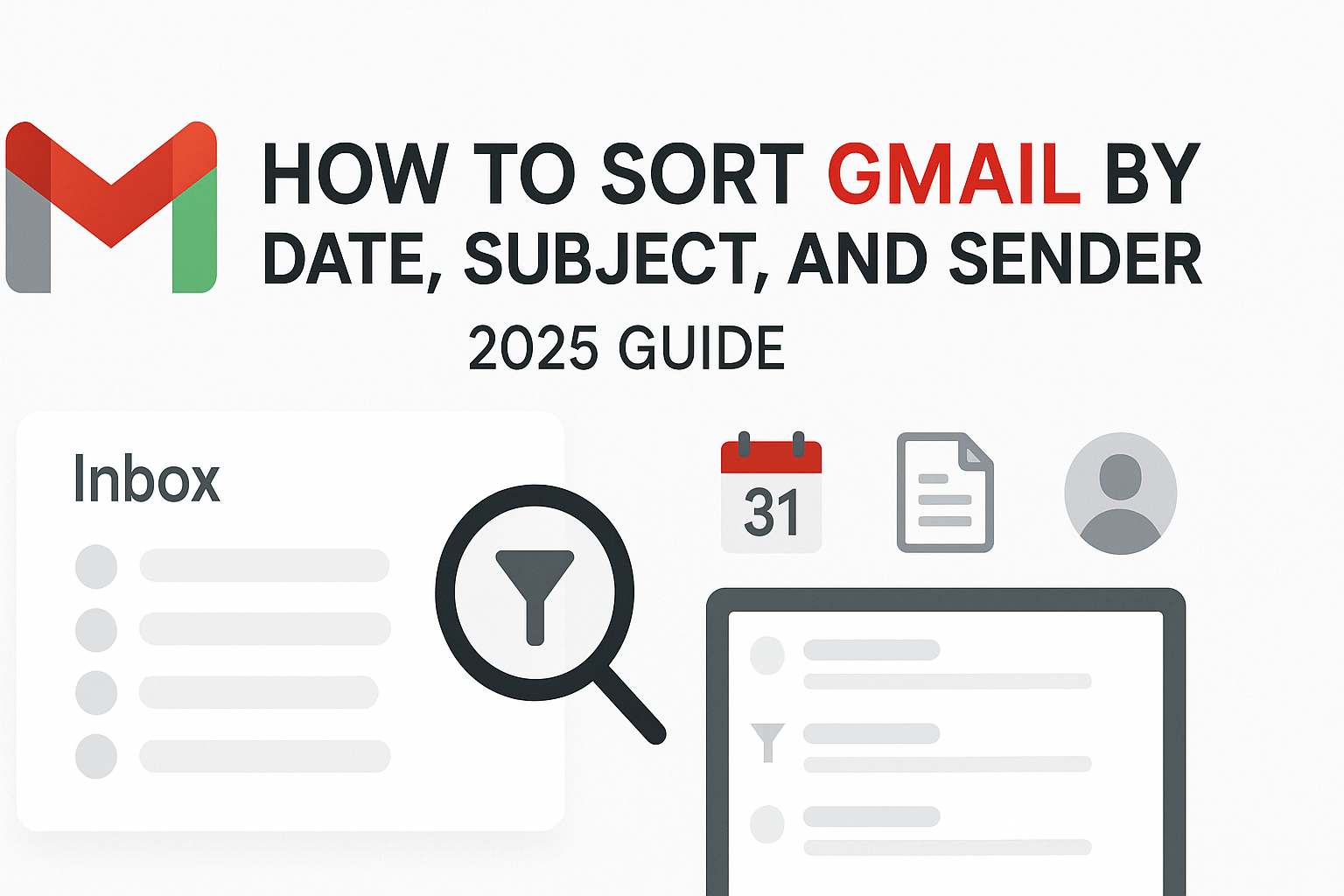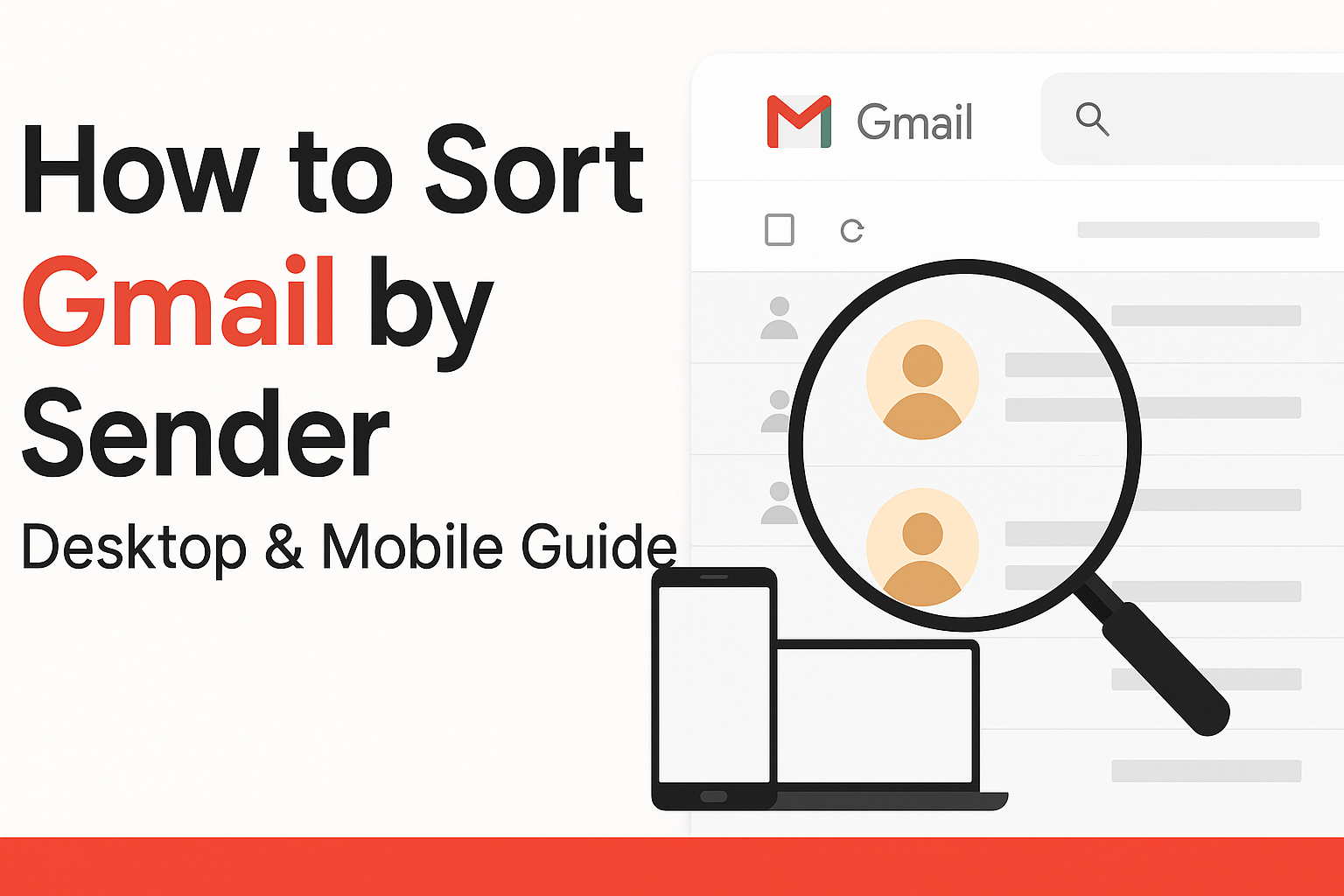Achieve Inbox Zero and finally take back control of your email. You open your inbox and instantly feel the weight: hundreds, maybe thousands, of unread messages. Some are urgent, many aren’t, and a few have been sitting untouched for weeks. You tell yourself you’ll deal with them later, but “later” never comes. Before long, your inbox feels less like a tool and more like a second job.
This is the reality for millions of people. Email overload wastes time, adds stress, and kills focus. Instead of boosting productivity, your inbox becomes the biggest distraction in your day.
That’s where Inbox Zero comes in. Despite the name, it’s not about obsessively keeping your inbox empty. It’s about building a system that keeps email under control, so you can focus on your real priorities, your work, your goals, and your peace of mind.
In this guide, you’ll learn what Inbox Zero really means, why it works, and the exact steps to reach it. We’ll cover practical tools, daily habits, and smart techniques that make Inbox Zero realistic, and sustainable. If email has been running your life, this is your chance to flip the script.
Understanding Inbox Zero
What Inbox Zero Really Means
Inbox Zero isn’t about obsessively deleting every message. It’s not about checking your email every 10 minutes. And it’s definitely not about replying to everything the moment it lands.
The concept was introduced by productivity expert Merlin Mann. It’s a system designed to help people deal with the constant flow of email by making clear decisions about every message; fast. Inbox Zero simply means your inbox is no longer a to-do list.
Most people let unread messages pile up. They check the inbox multiple times a day but avoid actually deciding what to do with each message. That creates a backlog of mental clutter. Each time you glance at your inbox, you’re reminded of something you haven’t handled yet. That distraction adds up.
Inbox Zero shifts that pattern. You process email instead of checking it. You sort, file, archive, or delete. You decide instead of deferring.
The “zero” doesn’t stand for the number of emails you’ve received. It stands for the amount of mental load your inbox should carry; zero.
The Philosophy Behind Inbox Zero
The real benefit of Inbox Zero is peace of mind. When your inbox is under control, your brain is free to think, create, and focus. You’re not weighed down by a vague sense of “something I forgot to do.”
Every message you leave unread is a decision postponed. That builds decision fatigue, which makes it harder to think clearly and stay on task. It’s the same mental toll that piles up when you delay doing the dishes or ignore a bill on your desk. Over time, the weight of those unmade decisions increases stress and reduces your ability to focus.
Inbox Zero helps you get rid of that mental noise.
It also improves your ability to prioritize. When your inbox holds only items that need action; nothing more, nothing less; you know where to put your energy. You respond faster. You miss fewer deadlines. You stop using email as a catch-all for tasks, notes, and reminders.
Common Obstacles to Achieving Inbox Zero
Poor Sorting Habits
One of the main reasons people fail at managing email is that they don’t know where to put things. Emails sit in the inbox because there’s no system in place for moving them elsewhere. You read a message, then mark it “unread” so you don’t forget. That doesn’t solve anything. It just adds to the mess.
Without folders, filters, or a workflow, your inbox becomes a pile of “I’ll get to this later.” That’s a trap.
Constant Notifications and Distractions
Ding. Buzz. Flash. Every email notification hijacks your attention. Even if you don’t open it, just seeing the subject line can pull you out of focus. These tiny interruptions drain energy throughout the day.
You stop writing. You lose your train of thought. You delay getting back into the zone.
If your inbox is always open or your phone is constantly pinging, your brain never gets a break. That leads to lower productivity and higher stress. Turning off notifications is a key step we’ll return to later.
Procrastination and Avoidance
Some emails feel heavy. A client complaint. A request that takes time. A confusing chain that makes no sense. These messages sit untouched because they demand energy or decisions you don’t want to deal with now.
The longer they sit, the worse they feel.
Inbox Zero works by helping you break through that avoidance. You’ll learn how to handle these messages with speed; not by ignoring them, but by acting or filing them in the right place.
Unclear Email Prioritization
Not all emails are important. But without a system, everything looks the same. You might spend an hour replying to newsletters or scheduling meetings while ignoring a message that actually moves your project forward.
Inbox Zero puts a focus on what matters. You’ll learn to sort and act based on urgency, context, and value; not just timing.
The Core Techniques for Achieving Inbox Zero
Inbox Zero doesn’t happen by accident. It’s built on simple, repeatable actions. Here’s what works:
- Batch Process Your Email
Don’t check email all day long. Instead, set two or three times each day to process your inbox. During these blocks, open your inbox, work through it, and close it. That keeps you in control and reduces constant switching. - Use Folders or Labels
Create basic folders or labels like Action, Waiting, Reference, and Archive. Every email should either go into one of these or get deleted. The goal is to keep your inbox empty and your folders organized. - Archive Instead of Deleting
Don’t worry about losing emails. Archive what you don’t need now but might need later. Search tools are good enough today that you’ll find it when you need it. Archiving clears the visual clutter while keeping the record. - Set Up Auto-Filters
Use filters to route recurring messages. Newsletters go to a “Read Later” folder. Bills go to “Finance.” Notifications go to “Updates.” This keeps your inbox clean and helps you focus on real messages first. - Apply the Two-Minute Rule
If you can respond to or handle an email in under two minutes, do it right away. Don’t mark it “read.” Don’t save it for later. Just do it. This rule alone clears 20–30% of messages fast. - Smart Replies Save Time
If your email app supports quick replies, use them. Respond with a simple “Sounds good” or “Thanks for the update” when appropriate. No need to write full paragraphs for basic exchanges.
Leveraging Technology to Maintain Inbox Zero
Use of AI-Powered Tools and Smart Filters
Managing your inbox manually takes time. But modern email platforms come with built-in intelligence. AI tools can read patterns in your email habits and suggest or automate common actions.
For example, some tools will automatically categorize your emails into primary, social, and promotions. Others can recognize recurring newsletters and file them into a “Read Later” label without any setup from you. These filters can be trained to spot which senders matter, what types of content should be archived, and which messages can wait.
AI doesn’t just sort; it learns. Over time, these systems get better at knowing what you care about. This means fewer interruptions, less clutter, and a cleaner inbox without lifting a finger.
To dig deeper into tools that help you clean your inbox with minimal effort, check out AI email organizers. It highlights smart assistants that simplify inbox cleanup using built-in intelligence.
Smart replies are another win. Email platforms like Gmail suggest short responses you can tap and send instantly. This helps reduce the time you spend crafting basic replies. It’s not about being lazy; it’s about saving time where it doesn’t need to be spent.
AI-powered scheduling tools can also coordinate meeting times based on your calendar and availability, cutting down endless back-and-forth emails.
The goal is to automate repetitive steps so you can focus on thinking, planning, and real communication; not manual sorting.
Automation and Integrations
You don’t need to be a tech wizard to use automation. Most email platforms today connect with apps like Google Calendar, Trello, Slack, or Notion. These integrations create workflows that automatically move information where it needs to go.
For instance, you can:
- Automatically create tasks from emails labeled “Action”
- Sync flagged messages with your to-do list app
- Turn meeting invites into calendar events without manual input
This reduces your mental burden. You no longer have to remember what came in and what needs action. Your system handles the transfer for you.
Some people also set up custom rules. If an email comes from a client, it gets tagged “High Priority.” If it includes attachments, it moves to a folder for contracts or files. These rules may take a few minutes to set up, but they save hours over time.
The best part is that this system works behind the scenes. Once in place, you’ll spend less time thinking about your inbox; and more time getting real work done.
Priority Inbox and Categorization
Priority inbox is a feature many email users overlook. But it’s a powerful tool when trying to stay on top of important messages. It automatically highlights the emails you’re most likely to care about, based on your behavior.
If you often open and reply to your manager’s emails right away, those messages will start showing up first. The ones you skip; like shopping deals or updates from mailing lists; get pushed further down or into different tabs.
This approach allows you to focus your attention where it’s needed most. You open your inbox and see only the messages that truly require your attention.
In combination with folders or labels, categorization becomes even more useful. You can separate personal messages, work-related updates, and bulk mail with minimal friction. You don’t need to sort them by hand; your email platform does the job for you.
These small features may seem insignificant, but together, they help you stay in control without added effort. Instead of fighting your inbox, you build a system that works with you.
Creating Sustainable Email Habits
Daily and Weekly Email-Checking Routines
Inbox Zero doesn’t stick unless you create habits that support it. It’s not just about cleaning up once. It’s about staying clean.
The most effective email users check their inbox at set times during the day. For most, two or three times is enough. Morning, mid-afternoon, and just before logging off works well. Outside of those windows, close your inbox. Don’t keep it open in a background tab.
This routine gives your brain the chance to focus on deeper work without getting interrupted.
Weekly reviews are useful, too. Pick a time; maybe Friday afternoon or Sunday evening; and scan your inbox folders. Clean out anything old. Make sure your “Action” folder is clear. Unsubscribe from newsletters that no longer serve you. Use this time to reset.
These habits don’t take long, but they keep you from slipping back into clutter. They let Inbox Zero become the new normal; not just a one-time project.
Managing Notifications
The fastest way to lose control of your inbox is to let notifications run wild. Every ping or buzz pulls your attention away from the task at hand; even if you don’t open the message.
Turn off notifications on your desktop and mobile devices. Instead, rely on your scheduled email-checking times to stay updated.
For truly urgent communication, use separate channels. Slack, SMS, or direct calls should be the method for time-sensitive conversations. Your email should not function as a fire alarm.
By removing notifications, you protect your attention. You’ll respond to messages faster and more clearly; because you’re not reacting, you’re acting on your terms.
Keeping Only Actionable Emails
Your inbox should never be a storage room. It should be a workspace. If a message doesn’t need action, move it out of the inbox.
Some people use a folder system. Others use stars or flags. The structure doesn’t matter; what matters is that your inbox only holds what still needs doing.
If an email is a reference, archive it. If it’s complete, delete or file it. If it needs a response, mark it “Action” and reply during your next email session.
This approach prevents you from getting overwhelmed. When you open your inbox, you’re not seeing 300 messages; you’re seeing the three that need attention.
That’s a big mental shift.
Unsubscribing From Clutter
You sign up for a discount once and forget about it. Next thing you know, you’re getting daily emails from that company; and dozens of others like it.
Unsubscribing is your friend.
Make it a habit to unsubscribe from one email every day. It takes 5 seconds. You’ll start to see big improvements within a week.
You can also use tools like Unroll.Me or built-in unsubscribe features to bulk remove unnecessary subscriptions. These messages may not seem like a big deal, but they steal attention over time.
Fewer distractions mean a cleaner inbox and a calmer mind.
The Long-Term Benefits of Inbox Zero
Mental Clarity
When your inbox is under control, your mind feels lighter. You no longer carry the background stress of unread messages or forgotten tasks. This isn’t just a nice feeling; it has real cognitive effects.
Mental clutter works like background noise. It distracts your thinking, slows decision-making, and increases stress. A cluttered inbox causes that noise every time you glance at it. Even seeing “1,284 unread messages” creates a subtle sense of pressure.
Inbox Zero reduces that tension. You know what needs to be done. You’ve made decisions. Your brain has space to think.
Many users report that after reaching Inbox Zero, they sleep better, concentrate longer, and feel more present in meetings and conversations. It’s not magic; it’s the relief of knowing nothing urgent is buried somewhere unseen.
Better Focus and Time Use
Email isn’t just communication. It’s often a source of interruption. Each time you switch tasks to check an email, your brain must shift attention. That shift costs time and energy.
With Inbox Zero, you control when and how you engage with email. You use structured time blocks, batch responses, and process messages quickly. You’re not checking constantly; you’re acting with purpose.
That change frees up hours every week. You stop rereading the same email five times before replying. You reduce meetings caused by missed messages. You work more, sort less.
Professionals who adopt Inbox Zero often report they can start their day with deep work instead of spending 45 minutes “clearing email.” That’s time you get back; every single day.
Professional Communication Gains
There’s a big difference between replying to emails reactively and responding with intent. When your inbox is organized, you respond faster and more clearly. You miss fewer deadlines. You follow up without effort. You come across as reliable and detail-oriented.
Colleagues, clients, and managers notice that. It builds trust.
You also spot patterns faster; issues that come up repeatedly, requests that could be streamlined, or opportunities you might have missed in the noise of a cluttered inbox.
By managing your inbox, you raise your communication quality and your professional image. That can lead to faster responses, better opportunities, and smoother collaboration across the board.
Conclusion
Email doesn’t have to control your day. It doesn’t need to be a source of stress, distraction, or mental clutter. Inbox Zero offers a proven approach for regaining control; one message at a time.
Start by understanding that Inbox Zero is not perfect. It’s a mindset. It’s about building a system where your inbox no longer feels like an open task list. You process, sort, and act. You clear your mental space so you can focus on meaningful work.
You’ve learned the main challenges; like sorting issues, notification overload, and procrastination; and how to move past them. You’ve explored tools, habits, and automations that make Inbox Zero sustainable. Whether it’s using AI filters or setting up a simple “two-minute rule,” the goal is the same: clarity and control.
Inbox Zero isn’t a one-time fix. It’s a habit; a way of managing information that supports your goals and clears the path for better thinking, faster decisions, and more creative work.
Start small. Stay consistent. The benefits will follow.
FAQs
1. How often should I check my email to maintain Inbox Zero?
Twice to three times per day is enough for most people. Morning, mid-afternoon, and end-of-day are good checkpoints. Avoid checking outside those windows unless absolutely necessary.
2. What do I do with emails that I can’t answer right away?
Move them to an “Action” or “Waiting” folder. These act as temporary holding zones. Check them during scheduled sessions when you’re ready to follow through.
3. Is it better to archive or delete old emails?
Archive emails you might need later. Delete only what you’re sure you’ll never reference. Modern search makes it easy to find archived messages, so you don’t need to keep everything in your inbox.
4. Can I use Inbox Zero with multiple email accounts?
Yes. Apply the same principles to each account. Use tools that unify multiple inboxes into one dashboard. Or keep separate tabs with distinct routines for each account.
5. What’s the first step to start Inbox Zero today?
Set aside 30 minutes. Start by archiving or deleting everything older than 30 days. Then process your inbox from newest to oldest using the two-minute rule. Create basic folders: Action, Waiting, Archive, and Reference.




